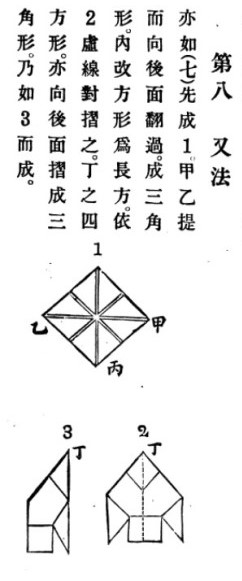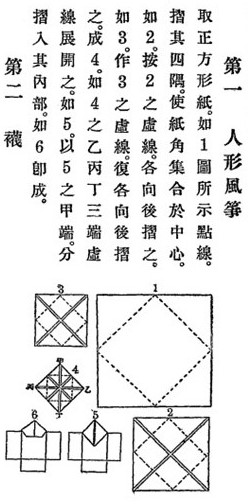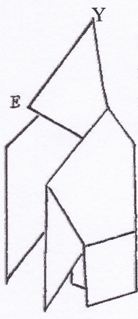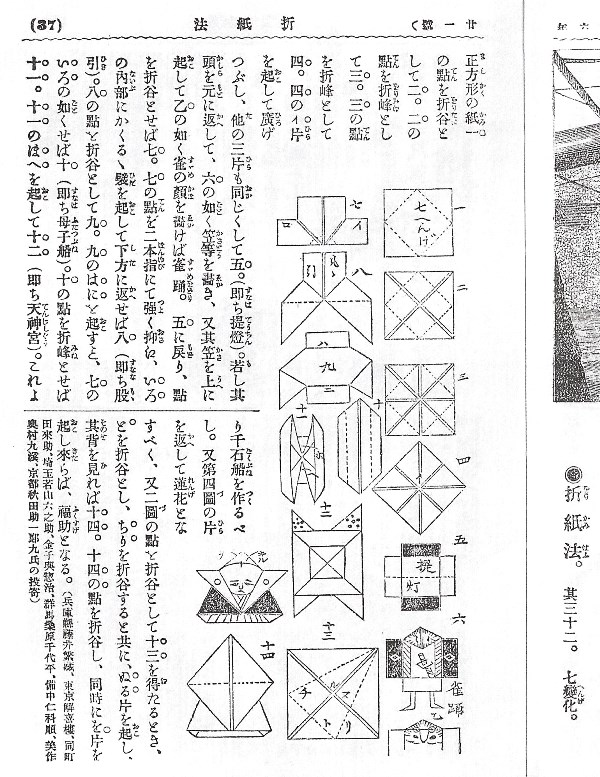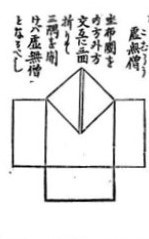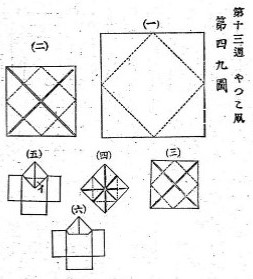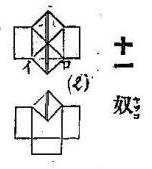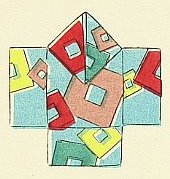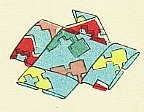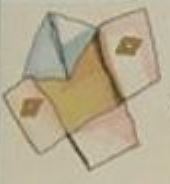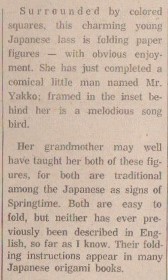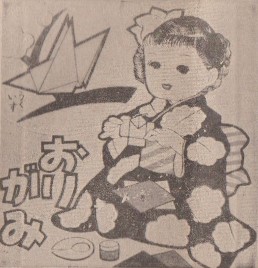| The Public Paperfolding History Project
Last updated 15/11/2025 x |
|||||||
| Yakko-san / Fukura Suzume / The Monkey | |||||||
| This page is being used to
collect information about the history of the paperfolding
design known variously as Yakko-san, Fukura Suzume (Baby
Sparrow) and the Monkey. Please contact me if you know
any of this information is incorrect or if you have any
other information that should be added. Thank you. ********** In China (and in publications by Chinese authors) 1914 Diagrams for Yakko-san, here called a 'Monkey', and a second 'Monkey' design derived from it (pictured on the right below), appear in 'Zhe zhi tu shuo' (Illustrated Paperfolding), compiled by Gui Shaolie, which was published by the Commercial Press in Shanghai in Ming guo 3 (1914).
********** 1917 Yakko-san also appears as 'Human-shaped Kite' in 'Xu Zhe zhi tu shuo' (More Illustrated Paperfolding) by Yongxiang Shi, which was published by the Commercial Press in Shanghai in 1917.
********** 1948 Another version of the second design, also titled 'Monkey', appears in 'The Art of Chinese Paper folding for Young and Old' by Maying Soong, which was published by Harcourt Brace and Company of New York in 1948.
********** In Japan (and in publications by Japanese authors) 1885 A picture of Yakkosan, but here called 'fukura suzume' (puffed-up sparrow), appeared in 'Kindergarten Shoho' (Preliminary Kindergarten) by Iijima Hanjuro, which was copyrighted on October 4th Meiji 17 (1884) and published by Fukuda Senzo in August of Meiji 18 (1885).
********** 1892 The design also appears in 'Kani Shukogaku' (Simple Handicraft) by Tamotsu Shibue, which was published in Tokyo in 1892, where it is called a 'fukura suzume' (puffed-up sparrow).'
********** 1894 The same design appears as 'Suzume Odori' (Sparrow Dance) in an article in issue 1894 / 21 of the Japanese children's magazine 'Shokokumin'. The top picture shows the design decorated to create a character wearing a sword and a woven straw hat. The second shows the same design with the head flipped backwards to reveal the face of a sparrow. This may be a representation of a dance that became popular in the early 19th century when a person would dress up like the top picture and then dance mimicking the movements of a sparrow.
********** 1905 A picture of the design appears in 'Shukouka Kyohon : Liron Jishuu Souga Setsumei' by Kikujiro Kiuchi, Rokushiro Uehara and Hideyoshi Okayama, which was published by Shigebei Takase in Chiba in 1905. I am unable to translate the title in this case.
********** The design also appears in 'Shukoka Kyoju Saian' by Gentaro Tanahashi and Hideyoshi Okayama, which was published by Hobunkan in Tokyo in 1905. The hiragana characters at the right say 'Yakko Kite'.
********** 1908 Diagrams that show how to convert the Lantern into Yakko-san (here called the 'General') appear in 'Origami zusetsu' (Illustrated Origami) by Sano Shozo, which was published in Tokyo in 1908.
********** 1912 A drawing of Yakko-san, and another of a closely related design with a different head (on the right), appear in a monozukushi-e print, by an unknown artist, but said to be from the Meiji era. I have temporarily assigned it the date of 1912, the last year of that era, pending the discovery of more accurate information.
********** 1927 A drawing of Yakko-san appears in an illustration by Takei Takeo in a 1927 issue of the children's magazine 'Kodomo No Kuni' (The Land of Children).
********** 1935 'Origami Moyo, Book One', by Kawarazaki Kodo, which was published by Unsodo in Japan in 1935, contains a print showing Yakko san.
********** 1944 'Yakko' also appears in 'Origami Shuko' by Isao Honda, which was published in 1944. The illustratin also shows a compound figure identified as 'Shojiki Chosan' made by combining Yakko-san with the Trousers.
**********
********** 1965 This design also appears as 'Yakkosan' in 'The World of Origami' by Isao Honda, which was published in the USA by Japan Publications Trading Company in 1965.
********** 1970 As 'New Yakkosan' in 'Origami Nippon' by Isao Honda, which is a paperback book published by Honda Origami Studio in Tokyo in 1970. The text says 'Since modern children could not understand we made them into a 'swaying toy' and a 'scarecrow''
********** In Western Europe and the Americas 1968 Vol 8: Issues 1 and 2 of 'The Origamian' for Spring and Summer 1968 contained an article, 'Origami Scrapbook ... Signs of Spring', written by Peter Van Note, about two Japanese designs, one of which was 'Mr. Yakko'.
********** |
|||||||

